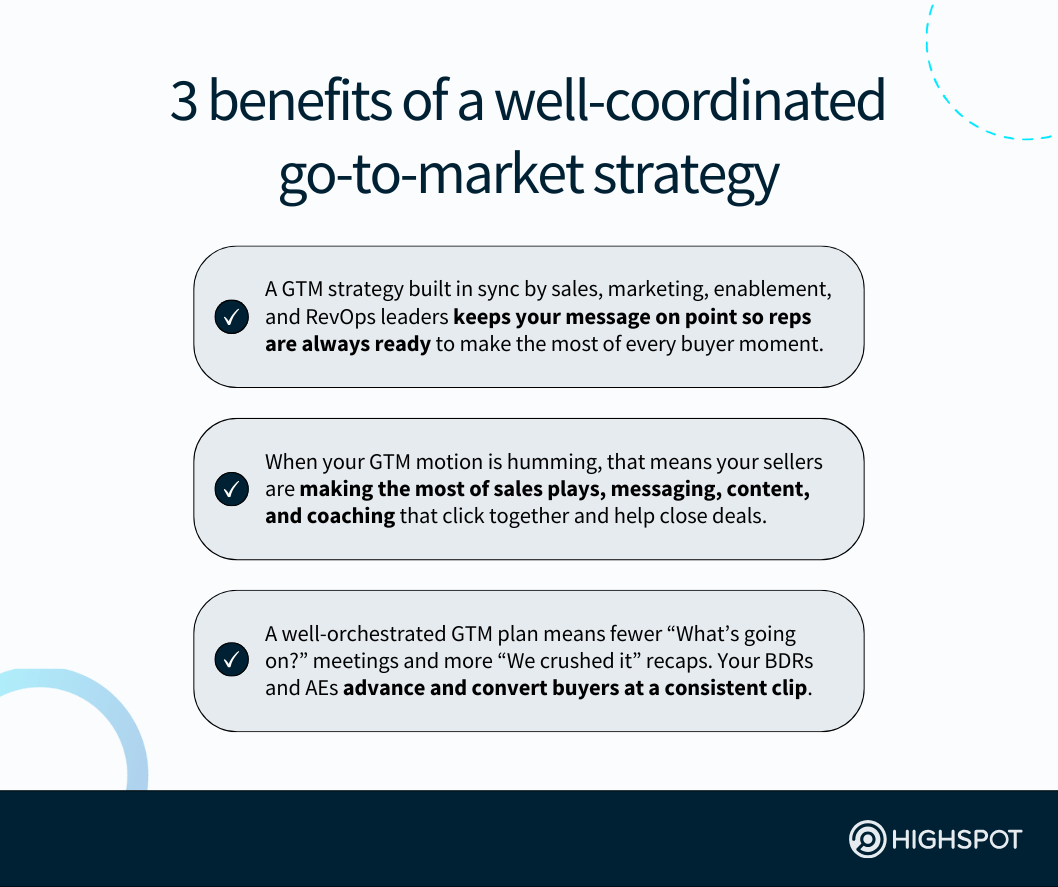Key takeaways
- A go-to-market (GTM) strategy aligns sales, marketing, and enablement, ensuring every part of a brand campaign or product launch process—from messaging development, to distribution and promotion—is well-executed.
- Roughly 85% of enterprises report that their GTM strategies have been highly effective in driving revenue and achieving core business objectives.
- Constantly analyzing and optimizing your go-to-market strategy enables your GTM teams—including and especially sales—to improve their work.
Product launches are complicated and expensive.
Like any other major business initiative, a go-to-market strategy intended to drive awareness of a new offering requires close coordination to execute efficiently, drive awareness and interest, and empower sales to sell smarter.
Marketing, enablement, and sales—the core of B2B go-to-market teams—all impact the success of their shared GTM strategies. Each business unit contributes in their own way:
- Marketing handles audience targeting, brand messaging, and content creation.
- Enablement equips reps with knowledge and resources to best engage prospects.
- Sales uses this collateral from their GTM counterparts to sell to high-value leads.
Despite their best efforts, these three functions sometimes fail to carry out high-performing and highly impactful go-to-market plans.
This can happen for a few key reasons:
- They operate entirely in silos, instead of collaborating closely with one another.
- They don’t have unified, centralized data and insights for leads and customers.
- They neglect to onboard and leverage emerging go-to-market performance technologies—like enablement solutions with native AI capabilities.
Fortunately, addressing this last item can help prevent the first two issues from occurring.
Whether you’re an emerging SaaS startup preparing for your first product launch or an established enterprise looking to execute expansion and upsell campaigns for existing and upcoming offerings, a GTM performance platform can unify your go-to-market teams and help them collectively drive consistent, predictable revenue growth for your business.
What is a go-to-market strategy?
A go-to-market strategy is a roadmap that outlines how a company will launch a product or service to new markets or existing ones. The approach entails getting your offering in front of the right audience at the right time and in the right way.
When developing a GTM strategy, your sales, marketing, and enablement leaders discuss:
- Who your target customers are currently and if that should change in some way
- What specific pain points your products solve for the ideal customer profile (ICP)
- How your business can best reach those potential customers across channels
- What makes your offerings unique and different from those of core competitors
Factoring in these focus areas, among others, helps your team craft a go-to-market plan that has clear goals, identifies strengths and weaknesses of previous GTM efforts (based on data analysis), and sets your reps up to build a more robust sales pipeline.
The power of a highly effective, well-coordinated go-to-market strategy
Go-to-market strategies aren’t just for startups going to market for the first time.
They’re just as vital for seasoned businesses that want to increase market share, adapt to market shifts, and strengthen their competitive stance in their industry and vertical.
Consider enterprise software companies.
- A well-planned GTM strategy is valuable for announcing product updates.
- When new integrations, features, or subscription plans become available, a GTM plan ensures existing customers and prospects understand the added value.
- For current customers, this boosts loyalty and retention and reduces churn.
- Go-to-market plans also play a pivotal role during mergers and acquisitions.
Product lines may be retired, or two products from merging vendors might integrate seamlessly. A thoughtful go-to-market plan can ‘relaunch’ these offerings to attract new customers or add value for existing customers.
“Robust GTM strategies add significant value for the businesses that put time and effort into developing and then implementing them,” Highspot’s GTM 101 guide noted.
“These strategies are more than just a way to announce a new product,” the guide continued. “They’re a tool for positioning, differentiating, and enabling sellers to drive deals forward with more confidence and efficiency.”
GTM strategy vs. marketing strategy
A go-to-market strategy aligns development, pricing, sales, distribution, and support to set the stage for greater market penetration.
In contrast, a marketing strategy may be a subset of the broader GTM motion, focusing on driving brand awareness and product demand.
The marketing strategy tied to a GTM plan usually involves carrying out email and social media marketing campaigns, publishing blog posts, conducting webinars and virtual events geared toward potential early adopters, and creating case studies for satisfied customers and brand evangelists that can be used as sales enablement content for reps.
In tandem with sales and enablement teams’ efforts, these types of marketing strategies ensure your product is ready for going to market and reaches your intended audience.
| Go-to-market strategy | Marketing strategy | |
|---|---|---|
| Purpose | Successfully launch a product or service to the market | Raise brand awareness, attract interest, and drive engagement |
| Focus areas | Establishing product-market fit, pricing, sales channels, support, customer success | Focusing on messaging, branding, content, advertising, and lead generation |
| Timing | Covers pre-launch, launch, and post-launch | Primarily active during and after the launch |
| Key metrics | Time to market, win rates, sales cycle length, customer retention, revenue impact | Customer acquisition cost, conversion rates, website traffic, lead quality |
The key benefits of a well-defined B2B go-to-market plan
Some of the key advantages of developing collaborative go-to-market strategies include:
Improved alignment across sales, marketing, and product teams
Sales, marketing, and product teams often have overlapping goals, but without a clear plan co-created with one another, they can pull in different directions and work in silos.
A synchronized and cohesive GTM plan developed among these teams, though, ensures every go-to-market team member knows their distinct role when going to market.
A great way to stay on the same page during GTM launches is to conduct regular, cross-functional team meetings with key stakeholders from each business unit.
For instance, your CMO, VP of Sales, and Enablement Director can meet with your CPO weekly in the months before a given product launch to improve their partnerships.
Meeting attendees can share their team’s latest progress, relay any challenges or obstacles preventing them from executing, and hold one another accountable for results.
Faster time to market for new product launches and campaigns
A structured go-to-market strategy accelerates launches while identifying potential risks early to mitigate problematic delays. It lays out the best ways to reach your audience, the right messaging, and the most effective marketing channels to deliver content.
Many GTM strategies include milestone tracking and risk assessment. Regular status reviews with key decision-makers allow sales, marketing, enablement, and other teams involved in the effort to flag and resolve issues early and prevent any project delays.
“Cross-team collaboration isn’t only part of the initial planning stage,” according to Highspot’s Successful Product Launch Strategy guide.
“It’s a crucial component to executing a strong launch. Bringing the right people together, defining roles and responsibilities, and communicating clearly throughout each phase of a launch ensures the transparency a business needs to achieve success.”
Better understanding of a target audience’s wants and needs
A well-planned go-to-market strategy also ensures businesses take the time to define their audience, research their competitors, and determine where their products fit.
This is especially important for product-led growth strategies, where the product experience your customers have with your solution itself drives acquisition and retention.
Recognizing the challenges facing your ICP and what your target audience looks for in a given solution can help your GTM teams personalize your marketing plan and craft unique value propositions to make the product stand out.
More importantly, you can leverage audience data and insights to plan for future products, create a better buyer experience, and improve customer relationships.

Competitive advantage over other companies in your space
Your business can outpace competitors with a thoughtful GTM strategy that focuses on your unique value proposition. Asking “What makes us different/better?” throughout your go-to-market planning is what can help you better position your products and services.
Once you collectively agree on the answer internally, use this brand story to shape your product messaging, pricing, and roadmap and craft a business narrative that stands out, sets your business apart from competitors, and connect with your ideal customer base.
Knowing market trends and competitive movements and launching GTM strategies at the most opportune time (this depends on what your data and market research tell you) with coordinated marketing campaigns are also key to staying ahead of the competition.
Strong resource optimization to effectively deploy GTM teams
Savvy go-to-market teams account for their time, budget, and personnel needs to work more effectively. Having a precise timeline that keeps every GTM team on an exact schedule and holds them responsible provides guardrails for GTM strategies.
Many B2B go-to-market teams also now utilize leading AI tools to create operational efficiencies with their GTM strategies—especially post-launch.
Many enterprises now use AI-powered sales enablement platforms like Highspot with built-in AI functionality that can help curate sales plays and digital sales rooms for reps, saving them hours each week and allowing them to pitch prospects more effectively.
10 steps to building a GTM strategy
Planning your go-to-market strategy certainly takes a while—usually several months.
That makes following a tried-and-true GTM blueprint, of sorts, the ideal way to develop your approach and decide on the distinct tactics and activities your sales, marketing, and enablement teams will work on individually and collectively.
Here’s a 10-step go-to-market process checklist that can guide your GTM teams.
1. Conduct market research
Take a detailed look at the state of the market. Conduct surveys, focus groups, interviews, and competitor analysis to ground your strategy and show you the real opportunities:
- Competitive analysis: Who are your competitors? How do they position themselves? What are their strengths and weaknesses? What gaps in their offerings can you fill?
- Customer insights: What are your potential customers’ challenges, pain points, and desires? Are there unmet needs? What solutions are they currently using, and where do those fall short?
- Market demand: Is there an existing need for your product? Are prospective customers actively seeking solutions, or will you need to educate the market?
- Industry trends: What trends are shaping your market? Is there emerging technology or changing consumer behavior you can capitalize on?
Once you have this data, you can ID opportunities for product and brand differentiation and identify the most profitable customer segments to target in your GTM motion.
Download our GTM Performance Gap Report to learn how your go-to-market organization can leverage AI to improve day-to-day productivity and steer strategic initiatives.
2. Define your target market
Deciding on a new ICP (or updating your existing ICP) requires you to examine data like:
- Demographics: Consider the age, tenure, seniority, and job title of key stakeholders—both financial decision-makers and team leaders—of your ICP.
- Firmographics: Investigate the sector, number of employees, annual revenue, and business model (B2B, B2C, SaaS, etc.) of your target accounts.
- Pain points and needs: Recognize the challenges your product solves for your ICP. The more closely you align your offerings with the Jobs to Be Done (pain points) of your target audience, the more likely your GTM strategy will resonate with them.
- Behavioral traits: How does this ideal customer make purchasing decisions? What does the customer journey look like? Are they typically looking for fast, cost-effective solutions, or do they prefer high-touch, premium products?
- Growth potential: Determine if companies that align with your ICP could grow with your product over time. For example, a startup that could eventually scale or a busy professional who might benefit from higher-tier offerings down the road.
Next, build detailed buyer personas to segment your target audience into specific groups.
Similar to ICPs, they help you see your customers as real people with unique needs, challenges, and motivations. They give insight into how buyers make decisions and what messaging resonates with each customer segment.
3. Craft compelling messaging
Your GTM team leaders must decide what they want your ICP to know about your product. Ask yourselves, “How do we want potential customers to feel when they think about us?”
Develop a unique value proposition highlighting why your offering is different (and better). Work with stakeholders to create messaging that speaks directly to customer needs, pain points, and goals, keeping value in mind.
Remember to include supporting evidence of your success claims.
Here are messaging examples for two buyer personas for a project management tool:
| Persona | Pain Points | Product Value | Messaging |
|---|---|---|---|
| Tech-savvy Cameron | – Needs a highly customizable tool that integrates with other systems – Wants automation to save time | – Highly customizable features – Integrations with popular tools like Slack and Google Workspace – Automates repetitive tasks | “Save time with powerful automation and integrations that fit right into your existing workflow. Our project management tool adapts to your needs.” |
| Corporate Claire | – Manages large teams and complex projects – Needs to ensure data security and privacy for sensitive projects | – Enterprise-level security – Advanced reporting – Scalable for large teams | “With enterprise-grade security and powerful reporting, our tool ensures your team stays efficient and your data stays safe.” |
Simply put, the better you know your audience, the better you can construct a messaging framework that tells them who you are and why your products are the ones they need.
4. Define your pricing strategy
Your pricing must reflect its value, be affordable to your target audience, and keep you competitive. Look at data tied to what price points contribute to closed-won and closed-lost opportunities and recent renewal, upsell, and cross-sell deals.
Scenario-test customer willingness to buy or subscribe at various price points, and adjust your model as needed. Just remember, your pricing will also affect your sales strategy.
Other key considerations to keep top of mind when creating your pricing strategy include:
- Understanding your costs: Know the baseline cost of delivering your product, including production, overhead, marketing, and sales.
- Looking at competitors’ rates: Compare your competitor’s prices for similar products. Do you offer a (seemingly) superior product? If so, you may be able to charge more. However, if you’re entering a saturated market, you may want to consider pricing competitively to attract more customers, then adjust over time.
- Factoring in customer perception: A higher price point might signal quality to some, while others may equate lower prices with affordability. It’s crucial to match the price with the value you’re providing.
- Tracking pricing-model trends: There are several models to consider: subscription, one-time purchase, tiered pricing, freemium, and the like. The ‘right’ model depends on your product, market, and customer behavior.
Also, consider promotions, discounts, or trial periods. These go-to-market tactics can help attract early adopters. Just use them strategically to avoid devaluing your product.
5. Develop a promotion strategy
Your promotion plan in your go-to-market strategy should align with where your audience spends their time and what initiatives grab their attention. Key components include:
- Content creation: Develop tailored content that speaks directly to your audience’s needs. This includes blog posts, sell sheets, guides, videos, social media posts, email campaigns, and more. The tone should align with your brand identity.
- Marketing and advertising: Leverage platforms where your audience spends their time. This might mean using search engine optimization (SEO) to increase search visibility, paid ads to target specific demographics, or even traditional media like TV or radio if that suits your audience.
- Events and webinars: Hosting events, product demos, or webinars can provide a personal touch, helping prospects understand your product’s value firsthand.
- Partnerships: Partner with experts, influencers, and/or complementary brands in or adjacent to your space to extend your reach and tap into new audiences.
The goal is to balance your inbound and outbound tactics, consistently feeding leads into your sales funnel and pipeline while also maximizing your marketing budget and time.
6. Choose the proper engagement channels
Consider how your audience prefers to buy. This is where your CRM system, business intelligence, and B2B sales enablement tools come into play.
Recent and historical data from these platforms, like those tied to GTM sales plays, can shed light on the most popular ‘places’ (website, email, calls, chat) where leads interact with you.
Highspot’s sales scorecards offer granular sales analytics tied to reps’ activities, including where and how they engage prospects across various channels. This helps GTM teams using our platform tie their enablement efforts to real business impact (new business).
Knowing the optimal channels to engage prospects, based on data from these tools, will streamline your sales process and ensure you reach the right people at the right time.
7. Set goals and define processes
Any successful go-to-market strategy requires clearly defined SMART goals—lofty yet realistic ones—and processes spanning the planning and post-launch phases.
During GTM planning, goals might include preparing marketing materials, training sales teams, or securing early adopters. Supporting processes focus on internal workflows, like defining a sales methodology, ensuring team alignment, and tracking readiness milestones.
Post-launch, the focus shifts to your sales and marketing teams:
- Sales teams track key performance indicators (KPIs), like those tied to reaching revenue and sales targets within 30, 60, or 90 days post-GTM launch.
- Marketing teams track audience engagement, customer acquisition cost (CAC), and conversion rate metrics tied to different segments targeted via GTM efforts.
Even your customer support and success teams can track metrics tied to service level agreements, like onboarding new customers generated post-GTM quickly and tackling tickets tied to implementation requests and general product questions in a timely manner.
8. Plan for risks
Going to market with new offerings geared toward your customer base is a relatively safe play, given the built-in audience (and wealth of data tied to them) that you have.
But diversifying into entirely new markets with a product launch is a high-risk, high-reward play that comes with some potential for failure (or at least missing target goals).
- What if your integrated marketing campaign misses the mark?
- What if your product development team is behind schedule?
- What if sales isn’t fully equipped to sell the offering?
Building contingency plans for these scenarios will save you headaches down the line.
9. Prepare internal teams
Conducting comprehensive go-to-market training for sales, marketing, and customer support and success teams ensures they’re confident in the product and their roles. Focus on key areas:
- Sales should know the core value proposition of all your solutions and capabilities
- Marketing should own messaging formation and, as new data emerges, modify it.
- Customer support and success should prepare to help new customers hit the ground running with your products and services to ensure high satisfaction.
A key component of live training is keeping lines of communication open with regular updates and shared resources. When teams are both prepared and aligned, they can deliver a smooth, standout customer experience that turns potential buyers into brand evangelists.
10. Conduct a final check-in
Before you go live on your projected GTM launch date, take the time to ensure that all teams are on the same page and have mutual success and performance goals to meet and specific metrics you can collectively monitor to ensure you meet those objectives.
“To fuel your trajectory, harness real-world data to optimize your new product’s performance in the field,” per Highspot’s Product Launch Strategy Built for Liftoff guide.
To achieve that, create a system for collecting feedback before launch:
- Market response: Soft launches or pilot programs can reveal how your target audience reacts to the product.
- Sales enablement: Test how well your sales team pitches the product. Are they hitting the key messages?
- Marketing effectiveness: Run small ad campaigns to test which messages and visuals resonate most with your audience.
- Product functionality: Identify and resolve bugs or usability issues before the official launch.
These provides valuable insights to refine your approach so it’s grounded in what actually works and enables you to forecast the likely impact and effectiveness of your GTM plans.
The outsized role of sales enablement in your GTM strategy today
Sales enablement is fundamental and foundational to a successful GTM strategy.
Our State of Sales Enablement Report 2025 found that 61% of executives are investing more in enablement to help drive go-to-market effectiveness. And it makes sense—teams need the knowledge, tools, and resources to confidently engage buyers and close deals.
Here’s how it supports the go-to-market process:
- Equip your sales teams with tools and training: Sales enablement strengthens sales efforts by providing product training, sales playbooks, and real-world examples to help reps confidently navigate conversations.
- Align on messaging: By collaborating with marketing, enablement equips reps with clear messaging, value props, and positioning, so they can connect with buyers’ needs, use the right content at the right time.
- Boost sales team performance during launches: Enablement prepares teams with structured sales onboarding and coaching well before a product or service launches. Sales reps receive tailored GTM training to address their questions and become armed with competitive comparisons and key talking points.
- Facilitate cross-team collaboration: Sales enablement bridges the gap between sales and marketing strategies. It ensures sales can access content like competitive differentiation intel or buyer feedback. Even more, sales can share customer feedback and sentiment with marketing to refine campaigns and messaging.
Go-to-market performance platforms that specialize in AI-powered sales enablement, like Highspot, support this by giving enterprise GTM teams such as yours one place to access training, content, and guidance.
This makes it easier to stay aligned and act quickly as plans evolve.
Consider Viant Technology. Highspot became a crucial part of the AdTech company’s GTM alignment. Thanks to centralized resources, reps became more self-sufficient, marketers maintained control over assets, and enablement saw a 109% boost in rep participation.
This, in turn, led to more proactive use of GTM collateral to educate, nurture, and convert customers and provide stellar buying experiences for each prospect Viant reps engage.
“Organizations need technology that aligns go-to-market teams, delivers a unified and actionable view of GTM initiative health, and provides coaching at scale, to drive frontline productivity,” according to Highspot’s Choosing the Right GTM Enablement Platform guide.
Translation: A GTM performance platform is absolutely critical for GTM success today.




